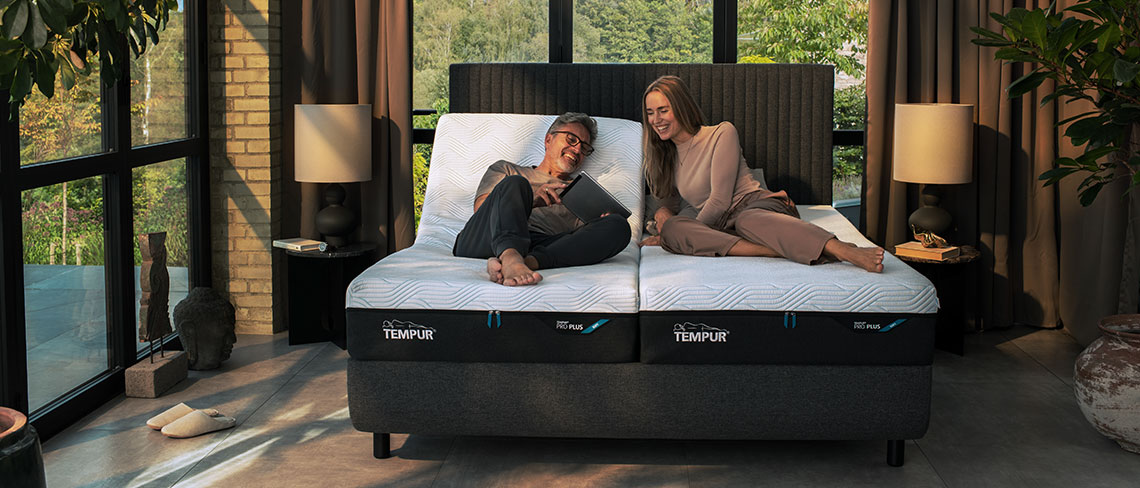
TEMPUR® sleep specialist & sleep counsellor shares guide to pain and sleep for Pain Awareness Month (September).
The impact of pain on sleep is not to be underestimated so this Pain Awareness Month Thomas Høegh Reisenhus, TEMPUR® sleep specialist & sleep counsellor, shares his complete guide to pain and sleep including strategies for ensuring a restorative night’s sleep.
Thomas says: “Pain impacts us all at different points in our lives, from teething pains as a baby to the aching joints typical of old age.
“Acute pain is caused by something specific – such as an injury – and tends to progress suddenly, lasting up to six months. Once the underlying cause is treated, the pain resides. Chronic pain on the other hand, is a long-term pain that persists beyond the usual recovery period and occurs along with a chronic health condition such as arthritis, back pain or neck pain. Chronic pain can be continuous or more sporadic.
“For those living with pain, a good night’s sleep can seem like a distant memory – and, frustratingly, poor sleep can worsen symptoms and even hinder our recovery process. However, whilst it may feel hopeless, there are some simple ways to encourage a better night’s sleep, such as by considering the importance of sleep ergonomics, daily routine and sleep hygiene.”
Read on for Thomas’s guide to pain and sleep…
Understanding the sleep cycle and the impact of pain
In order to enjoy high-quality sleep and wake up feeling well-rested, we need a balance of the four phases of sleep – namely, REM (rapid eye movement) and three stages of Non-REM.
Stage 1: the lightest and briefest stage of sleep, lasting between one and seven minutes.
Stage 2: lasts between 10 to 25 minutes, though is still considered a light phase of sleep. During this phase of sleep muscles relax and body functions slow.
Stage 3: A deeper, more restorative stage of sleep that usually lasts between 20 and 40 minutes. This stage of sleep is more difficult to wake up from.
Rapid eye movement (REM): The phase of sleep where dreaming tends to take place and where the body’s muscles are temporarily paralysed.
Whilst sleep isn’t uniform – we all have our own unique sleep cycle – over a typical night, a person goes through four to six sleep cycles, lasting about ninety minutes each.
Pain can affect sleep in different ways and is very much dependent on the nature of the pain. For example, some conditions flare up at night or are provoked by certain sleeping positions whereas other conditions cause a more persistent pain that simply doesn’t ease at night.
As a result, frequent nighttime wakings are common in those struggling with pain; these wakings disrupt the sleep cycle, interrupting the progression of sleep stages and leading to a less restorative night’s sleep and next-day tiredness.
In fact, people living with chronic pain may also end up suffering from the side effects of a long-term lack of sleep such as difficulty concentrating and processing information, mood swings, impulsive behaviour, anxiety, depression, and at increased risk of chronic conditions such as diabetes and heart disease.
Whilst managing pain isn’t straightforward, it’s important to focus on the things you can
control – from daily routine to sleep hygiene.
Sleep hygiene
Waking up and going to bed at the same time every day is crucial to establishing a solid sleep-wake cycle.
Beyond this, ensuring your bedroom is the ideal environment – quiet, dark and cool (at about 18°C) – will also help to facilitate a better night’s sleep. Invest in a comfortable eye mask, black-out blinds and ear plugs to help ensure optimal conditions.
Likewise, ensure that any bedding and nightwear are made of breathable, natural materials such as cotton or linen to help your body keep cool in the night and, consequently, reduce the risk of sleep disruption due to overheating.
Before heading to bed, engage in diaphragmatic breathing – an exercise technique to help strengthen your diaphragm and fill your lungs with air more efficiently – which can help in managing symptoms of both chronic pain and sleep disorders, while lowering blood pressure and heart rate . The perfect pre-bed wind down.
The role of exercise
Enjoying regular exercise is known to improve both quality and quantity of sleep and while it may sound counterintuitive for those struggling with pain, it can help in the long run.
Strengthening muscles and increasing mobility is vital for everybody – especially as we get older. Resistance training like weights and Pilates are popular options as they can be used as a tool to strengthen weaker muscles that could be the source of pain or contributing to muscle imbalances. Swimming is another great option as it doesn’t put as much pressure on your joints as other forms of exercise, but still offers the same strengthening benefits.
The key thing is to find an exercise you enjoy – whether that’s because it means spending time with friends or love of the activity itself – that way you are more likely to return to it time and time again.
*Be sure to speak to your doctor or physical therapist before starting a new training regime.
Power napping
Whilst a nap isn’t a replacement for a good night’s sleep (as a 10–30-minute nap isn’t long enough to enter the deeper stages of sleep), if pain is impacting your ability to sleep at night, power naps may help you to feel more rested. Naps have also been shown to improve alertness, memory, boost mood and increase creativity.
The best time to nap is early afternoon, before 3pm, as any later may interfere with your ability to sleep come nighttime. And make sure to nap for no longer than 30 minutes – any longer and you’ll enter a deeper phase of sleep which, if then interrupted, will leave you feeling groggy and disorientated post-nap.
If you need a little help waking up again, try splashing some cool water on your face or soaking up some natural sunlight. Alternatively, try drinking a cup of coffee, or similar caffeinated drink, prior to napping. The caffeine will start to kick in after around 20 minutes, just as you’re waking from you nap, giving you an extra energy boost.
Sleep ergonomics
Many people struggling with pain don’t realise that what they are sleeping on could be exacerbating symptoms.
Your mattress and pillow should adapt to you, distributing your weight evenly and keeping your neck and spine in alignment, absorbing pressure to aid comfort and relieve pain points.
If you struggle to find a comfortable sleeping position, it’s worth considering a bigger bed that will allow plenty of space for you to move around and find the sleeping position that’s most comfortable for you.
Investing in the best quality mattress and pillows you can afford will help ensure optimal levels of comfort and support, facilitating a restorative night’s sleep.
For more information, visit www.tempur.co.uk.
-Ends-
Notes to editors:
Please contact us should you be interested in receiving TEMPUR® product for review or for competition prizes.
For further press information, please contact:
Tilly Everard | Elsa Findlay | Julie Aguilera
Rooster.
T: +44 (0)203 440 8930
E: [email protected]
About TEMPUR®
TEMPUR® researches, develops, manufactures and distributes mattresses, pillows and other sleep products to improve the sleep experience worldwide.
TEMPUR® Material is the original pressure relieving mattress product made up of viscoelastic – billions of ultra-sensitive open cells that exist between a solid and a liquid state. TEMPUR® products provide the ultimate comfort and support, helping you to get a great night’s sleep night after night.
Each TEMPUR® mattress undergoes sixty-seven different quality checks, ensuring superior quality and durability.
TEMPUR® products can be purchased direct via the TEMPUR® UK website, Dreams, John Lewis, Bensons for Beds, and Furniture Village or from leading independent retailers or from any of 10 TEMPUR® brand and outlets stores.
TEMPUR® is a subsidiary of TEMPUR® Sealy International Inc. www.tempur.co.uk
Follow TEMPUR® on X, Facebook, Instagram and YouTube.






